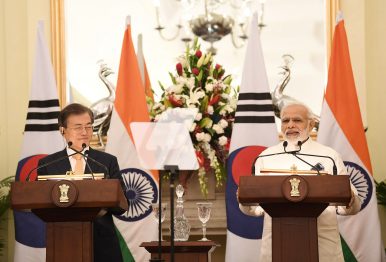By Rajeswari Pillai Rajagopalan
In the first week of September, Indian Defense Minister Rajnath Singh was on a five-day tour of Northeast Asia, making South Korea his second stop after Japan. During the visit, the Indian minister met his counterpart, Jeong Kyeong-doo, with the two leaders highlighting the potential for expanding their cooperation in the defense and security sectors.
After undertaking a comprehensive review of the defense relations, the ministers signed two agreements, one to extend logistical support to each other’s navies, and a second one to deepen defense educational exchanges. The agreement on naval logistics sharing is particularly a significant one, given that India has such arrangements so far only with the United States and France. India is currently negotiating such an agreement with Japan.
While it is a clear demonstration of the deepening strategic partnership between India and South Korea, the military logistics agreement will also go a long way in enhancing India’s strategic reach in the Indo-Pacific. India’s limited naval presence in the Pacific can be addressed by the agreement as the Indian military will be in a position – to take just one example – to use the South Korean military facilities if needed.
In another important development, the two countries have developed a roadmap that will strengthen India-South Korea defense industry collaboration. This is a key area given that the Indian government has decided not to use Chinese systems and components in the broad defense electronics sector and India is yet to develop indigenous capability to fill in this gap.
Given the high-end and sophisticated nature of the South Korean defense electronic capabilities, this offers itself as an ideal win-win opportunity for Seoul and New Delhi. A defense ministry statement noted that Rajnath Singh, at a meeting of the CEOs of Korean and Indian defense industries in Seoul, listed a number of possible areas for cooperation including land systems, aero systems, naval systems, R&D co-operation and collaboration in testing, certification, and quality assurance.
Elaborating on the defense trade potential in India, the minister went on to add that “India offers tremendous business opportunity to Korean defense industries in India with liberalized licensing regime, attractive FDI provisions, strong and skilled industrial work force, single window clearances and establishment of Defense Investor Cell to facilitate investors and various other industry friendly initiatives.”
Other lines of effort also bear noting in this regard. For instance, the defense minister also invited the Korean defense industry to participate in the next DefExpo — DefExpo 2020 — that will be held in Lucknow in February 2020. The Indian defense minister has also established a joint task force to identify military systems and hardware that can be produced in India through the participation of Korean defense industries, which will be useful in avoiding the import costs of these systems.
India’s push for stronger defense cooperation comes against the backdrop of the Indian Army’s induction of the K-9 Vajra self-propelled howitzers, which is a version of the South Korean K-9 Thunder. South Korean defense industry, Samsung-Techwin, and India’s Larsen & Toubro had entered into an agreement for the sale of 100 howitzers in May 2017.
The first batch of these howitzers entered service in November 2018, with the second batch to be supplied in November 2019 and the final batch of 50 is to be delivered in November 2020. The South Korean Defense Acquisition Program Administration (DAPA) announced in 2016 that it is working on a new fully automatic projectile-and-charge loading system that will be retrofitted to the K9, fitting the howitzers with a robotic turret, thereby reducing the role of crew operating the howitzers. Partnership between the Indian Larsen & Toubro and the Samsung-Techwin could strengthen indigenous effort to develop and strengthen remote control systems in India’s defense sector.
According to the defense ministry statement, the minister had also said that “We are progressing towards becoming a manufacturing hub of defense equipment and investors can use India as a spring board to export defense equipment manufactured in India to various friendly countries in South East Asia, Middle Asia, Middle East Asia, South Asia and Africa.”
The broader push for India-South Korea defense and strategic collaboration was taken during Prime Minister Narendra Modi’s visit to Seoul in February this year. There is a growing synergy and complementarity between South Korea’s New Southern Policy and India’s Act East Policy, both of which seek to establish a stable, secure and prosperous Indo-Pacific order. Recalling President Moon Jae-In’s visit to India in 2018, Modi said during his Korea visit that “the coordination of India’s Act East Policy and Korea’s New Southern Policy is giving a strong platform to further deepen and strengthen our Special Strategic Partnership.” He further added, “we have made significant progress in our relations in a very short time. This is based on our shared vision of progress and roadmap of our relations in future, people, peace and prosperity.”
While India’s relations with South Korea are improving, it remains to be seen how New Delhi will maneuver around a couple of trouble spots. One is the worsening tensions between South Korea and Japan, another of India’s vital strategic partners in the region. A more critical one is Seoul’s closeness to China (despite South Korea’s own occasional difficulties with Beijing). Both require careful and sensitive handling.

